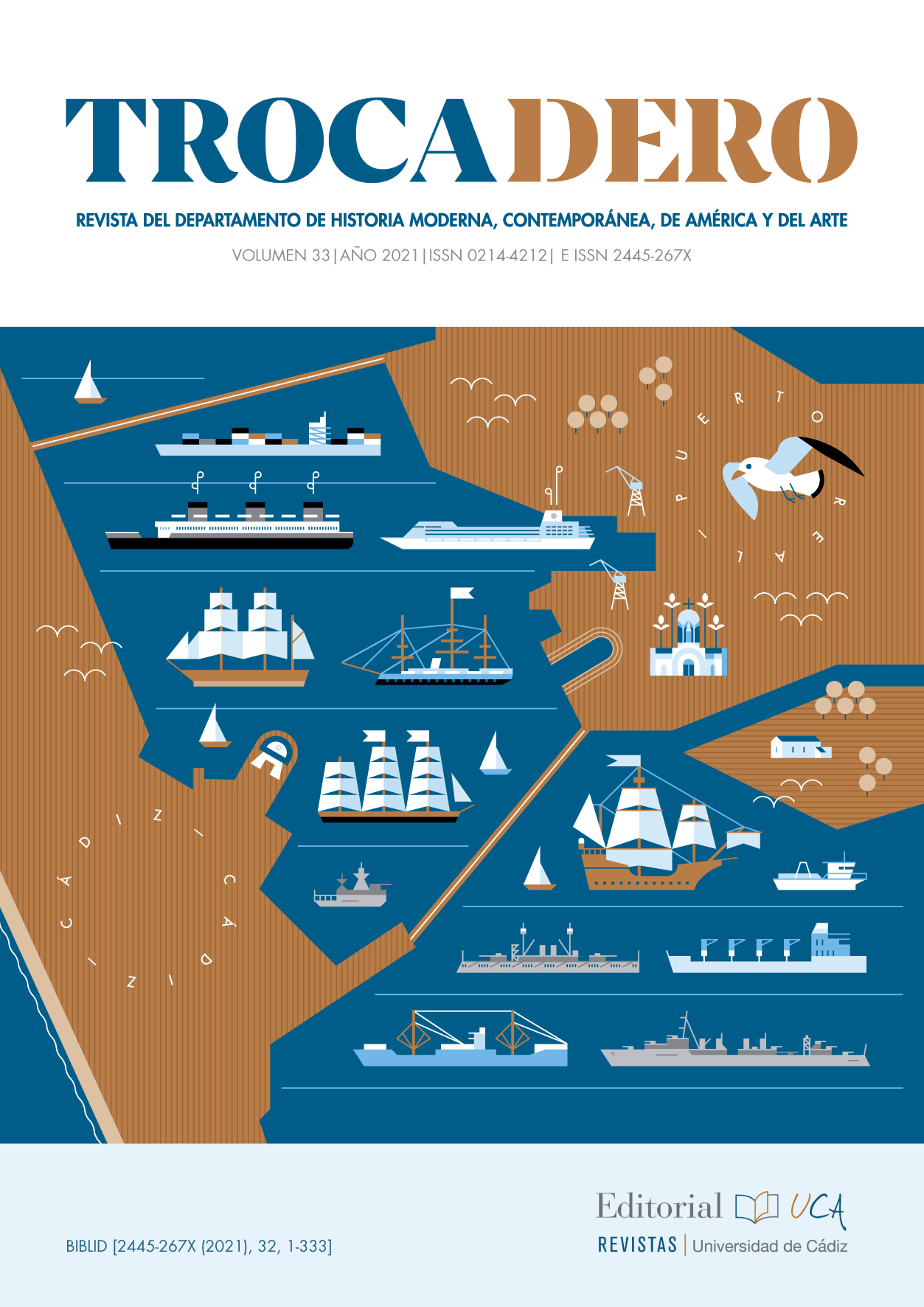Picasso, sculptures and series in mixed artistic techniques in Vallauris (1951-1954)
Abstract
One of the most original sculptural methods invented by Picasso was the mixed technique that Werner Spies called encyclopedic, based on his explanations and the testimony of Françoise Gilot, with which he started from the assemblage technique and endowed it with a new character with which technical creativity proceeded with unusual freedom, once again generating a new space or foundation for representation. He used this method for
two decades in successive stages in Boisgeloup, Paris and Vallauris, between 1933 and 1954. The article presents the catalog and detailed analysis of all the sculptures that Picasso made in this last locality between 1951 and 1954, taking into account that they are the last of a singular procedure; and that in that brief stage he made the only series that respond to it, in
contrast to the individual character of all previous encyclopedic production. Both the study of all the works individually and in detail, and not with the generic and selective approaches with which it has always been treated; like the consideration of the series themselves, they have an unpublished character that will contribute to the knowledge of Picasso´s sculpture from new points of view.
Keywords
Downloads
How to Cite
License
Copyright (c) 2022 Andrés Luque Teruel

This work is licensed under a Creative Commons Attribution-NonCommercial-NoDerivatives 4.0 International License.
Authors who publish in this journal agree to the following conditions:
- The authors retain copyright and grant the journal the right of first publication, allowing third parties to use the published work as long as they mention the authorship and first publication in this journal.
- Authors may subscribe to other independent and additional contractual arrangements for non-exclusive distribution of the version of the article published in this journal (e.g., inclusion in an institutional repository or publication in a book) as long as they clearly indicate that the work was first published in this journal.
The terms of the licence can be found at the following link:
https://creativecommons.org/licenses/by-nc-nd/4.0/

References
APOLLINAIRE, Guillaume. Obras completas. París: Gallinard, 1965.
BIALOSTOSCKI, J. El simbolismo de van Gogh. Estilo e iconografía. Barcelona: 1973.
CARLSTON, Víctor I. Picasso. Drawings and Watercolors,1899-1907. Baltimore: Museo de Bellas Artes, 1976.
BLUNT, Anthony; y POOL, Phoebe. Picasso, the formative years. Londres: 1962.
COMBALÍA, Victoria. Picasso-Miró. Miradas cruzadas. Madrid: Electa, 1998.
GILOT, Françoise; y LAKE, Carlton. Vida con Picasso. Barcelona: 1965.
GOMBRICH, E. H. Sobre la percepción fisiognómica. Meditaciones sobre un caballo de juguete. Barcelona: 1968.
KAHNWEILER, Daniel-Henri; y BRASSAÏ. Picasso´s Sculptures. París: 1948.
LUQUE TERUEL, Andrés. Sobre la pervivencia del sentimiento trágico, Picasso versus Goya, Los fusilamientos.., Sevilla: Pensamiento y Arte, 1997.
LUQUE TERUEL, Andrés. Juego, ser y sentido del Arte. Sevilla: Tertulia de Pensamiento Arte y Estética, 1999.
OCAÑA, María Teresa; y TAVEL, Hans Christoph von. Catálogo. En VVAA. Picasso, 1905 y 1906. Barcelona: Electa, 1992, pp 107-397.
OLIVIER, Fernande. Recuerdos íntimos escritos para Picasso. París: 1988.
PENROSE, Roland. Picasso, su vida y su obra. Barcelona: Argos Bergara, 1981.
PENROSE, Roland. Picasso. París: Flammarion, 1982.
PIOT, Christine. 1945-1952. En VVAA. Picasso Total. Barcelona: Polígrafa, 2000, PP. 359-396.
QUINN, Edward. Picasso. Die objekte. Wien: Brandstätter, 1997.
SPIES, Werner. Picasso escultor. Stuttgart y Barcelona: Polígrafa, 1971.
SPIES, Werner. La escultura de Picasso. Barcelona: Polígrafa, 1989.
SPIES, Werner. Picasso sculpteur. París: Editions du Centro Pompidou, 2000.
STEIN, Leo. Apreciation: Painting, poetry and prose. New York: Crowe, 1947.
VELÁZQUEZ, Fausto. La escultura sevillana en la época de la Exposición Ibero-Americana, 1900-1930. Ávila: Diario de Ávila, 1989.
VVAA. Pablo Picasso. 25 octubre. 1881-1981. Sevilla: Obra Cultural del Monte de Piedad y Caja de Ahorros de Sevilla, 1981.
VVAA. Picasso 1905-1906. Barcelona: Electa, 1992.
VVAA. The sculpture of Picasso. Nueva York: MOMA, 1967.
VVAA. Picasso Total. Barcelona: Polígrafa, 2000.
VVAA. Picasso Sculpture. Nueva York: MOMA, 2015.
WALTER, Ingo F. Pablo Picasso, 1881-1973. El genio del siglo XX. Colonia: Benedikt Taschen, 1990.
WARNCKE, Carsten-Peter. Pablo Picasso, 1881-1973. Colonia: Benedikt Taschen, 1992.
KAHNWEILER, Daniel-Henri. Conversación con Picasso el día 2 de octubre de 1933. Le Point. 1952, XLII, Souillac, pp 22-27.
LUQUE TERUEL, Andrés. Picasso, el desarrollo del sistema en la dimensión escultórica propia, de 1914 a 1924. Norba-Arte. 2005, Vol. XXV, pp. 199-217. LUQUE TERUEL, Andrés. Picasso. Sistema creativo propio. Espacio y Tiempo. 2007, nº 21, pp. 95-121.
LUQUE TERUEL, Andrés. Revisión y naturaleza de las esculturas de Picasso con materiales y objetos encontrados, en Tremblay-Sur-Mauldre y París, en 1935 a 1941. Laboratorio de Arte. 2011, nº 23, pp. 465-490.
LUQUE TERUEL, Andrés. Picasso y Christian Zervos, los dibujos escultóricos del cuaderno de Cannes, en 1927, y las esculturas biomórficas modeladas en París, en 1928. Ars Longa. 2012, nº 21, pp. 407-428.
LUQUE TERUEL, Andrés. La primera indagación cubista de Picasso: Espacio interior I, II y III (Horta de Sant Joan y Barcelona, 1898-1899). Boletín de Arte. 2014, nº 35, pp. 187-205.
LUQUE TERUEL, Andrés. Picasso, los vaciados de modelos naturales y objetos reales (en Boisgeloup, en 1933 y 1943, y París, en 1934 a 1937). Erebea. Revista de Humanidades y Ciencias Sociales. 2015, nº 5, pp. 289-306.







